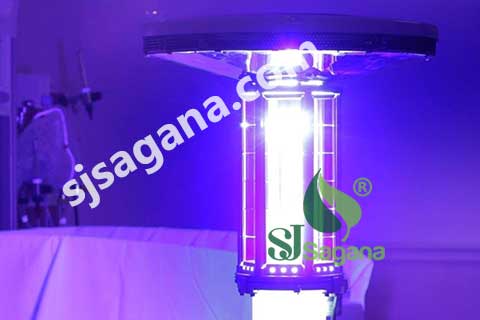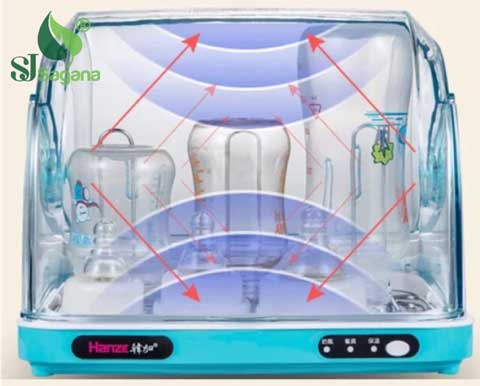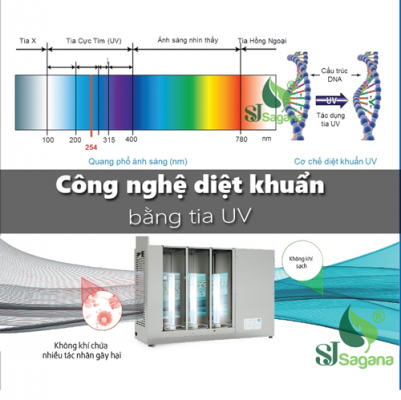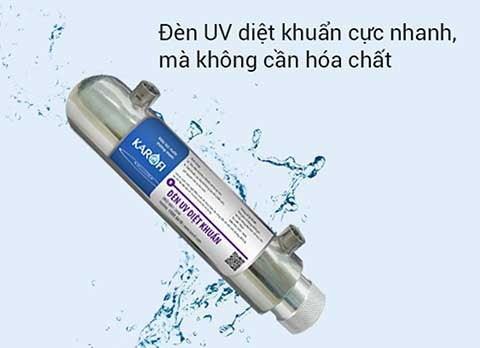Technology News
What is UV (Ultraviolet) Light? How is UVC Radiation Used to Combat COVID-19?
Currently, the market offers a variety of UV light products that are widely used. These products are promoted for their positive effects on consumers through the utilization of modern technology. One of the key technologies contributing to the quality of these products is the air disinfection technology using UV rays. So, how does this technology work and what impact does it have on human health? The following article will analyze this to provide consumers with a clearer understanding.
 Introduction to UV light:
UV light, also known as ultraviolet light, is a type of light that is not visible to the naked eye. This is because it is allocated between X-rays and visible light in the electromagnetic spectrum.
UV light has a shorter wavelength than visible light but longer than X-rays.
Types of UV rays:
Introduction to UV light:
UV light, also known as ultraviolet light, is a type of light that is not visible to the naked eye. This is because it is allocated between X-rays and visible light in the electromagnetic spectrum.
UV light has a shorter wavelength than visible light but longer than X-rays.
Types of UV rays:
 UV rays not only help the body absorb vitamin D but also contribute to better muscle function and a strengthened immune system. Additionally, they play a role in reducing the risk of certain colorectal cancer-related conditions.
Treatment for Non-Skin Diseases:
Diseases such as psoriasis, keratosis, and itchy scaling due to attacked skin cells can be treated with UV rays. Exposure to ultraviolet rays slows down the development of these bacteria, minimizing symptoms on the skin.
Mental Well-being:
Numerous studies indicate that sunlight, including UV rays, stimulates the pineal gland in the brain to produce tryptamines. This substance helps improve human mood significantly. Therefore, people are encouraged to engage in outdoor activities more often.
Disinfection and Sterilization:
UV rays have disinfectant and sterilizing effects, killing microorganisms, bacteria, and viruses in the air. Many people often expose their belongings to sunlight to efficiently disinfect and eliminate viruses and bacteria.
UV technology has diverse applications beyond its role in vitamin D synthesis, showcasing its potential in healthcare, disease treatment, mental health, and sanitation.
UV rays not only help the body absorb vitamin D but also contribute to better muscle function and a strengthened immune system. Additionally, they play a role in reducing the risk of certain colorectal cancer-related conditions.
Treatment for Non-Skin Diseases:
Diseases such as psoriasis, keratosis, and itchy scaling due to attacked skin cells can be treated with UV rays. Exposure to ultraviolet rays slows down the development of these bacteria, minimizing symptoms on the skin.
Mental Well-being:
Numerous studies indicate that sunlight, including UV rays, stimulates the pineal gland in the brain to produce tryptamines. This substance helps improve human mood significantly. Therefore, people are encouraged to engage in outdoor activities more often.
Disinfection and Sterilization:
UV rays have disinfectant and sterilizing effects, killing microorganisms, bacteria, and viruses in the air. Many people often expose their belongings to sunlight to efficiently disinfect and eliminate viruses and bacteria.
UV technology has diverse applications beyond its role in vitamin D synthesis, showcasing its potential in healthcare, disease treatment, mental health, and sanitation.
 Application of UV Rays in Disinfecting Household Items
The mechanism of UV rays involves penetrating cell membranes and disrupting the DNA of bacteria, preventing them from regenerating and multiplying. Thanks to this, many people have used UV germicidal lamps for highly effective disinfection.
Application of UV Rays in Air Disinfection:
Currently, there are numerous products on the market that utilize UV rays to effectively eliminate bacteria and viruses. Applications of this UV technology include:
In Air Purifiers:
Air purifiers and bacteria-killing devices are equipped with UV light fixtures, which are widely available. These fixtures assist in removing bacteria from the air as it passes through the light. This ensures more effective air purification. The cost of using these UV lamps is reasonable, and they operate reliably and efficiently.
Application of UV Rays in Disinfecting Household Items
The mechanism of UV rays involves penetrating cell membranes and disrupting the DNA of bacteria, preventing them from regenerating and multiplying. Thanks to this, many people have used UV germicidal lamps for highly effective disinfection.
Application of UV Rays in Air Disinfection:
Currently, there are numerous products on the market that utilize UV rays to effectively eliminate bacteria and viruses. Applications of this UV technology include:
In Air Purifiers:
Air purifiers and bacteria-killing devices are equipped with UV light fixtures, which are widely available. These fixtures assist in removing bacteria from the air as it passes through the light. This ensures more effective air purification. The cost of using these UV lamps is reasonable, and they operate reliably and efficiently.
 Application of UVC Technology in Air Disinfection
The National Science and Technology Development Agency (NSTDA) in Thailand has recently introduced a virus-killing robot using ultraviolet (UV) light called the “Germ Saber Robot.” This robot emits ultraviolet-C (UVC) rays with a wavelength of 250nm, enhancing its effectiveness in disinfection. UVC rays can destroy the DNA of the COVID-19 virus, bacteria, mold, and other pathogens (source: Tuoi Tre newspaper).
Additional Information: How Does the YW20201 Air Sterilization Device Using UVC Technology Work?
In Water Purifiers:
UV rays are also effective in disinfecting water environments. To ensure microbiologically safe water, UV lamps can be used for bacterial disinfection. Modern water purifying devices are equipped with UV lamps to achieve optimal bacteria elimination. These devices do not introduce any strange tastes or odors to the water.
Top UV Lamp Manufacturers:
Several UV lamp brands are available on the market for consumers to choose from. Some highly-rated brands include:
Application of UVC Technology in Air Disinfection
The National Science and Technology Development Agency (NSTDA) in Thailand has recently introduced a virus-killing robot using ultraviolet (UV) light called the “Germ Saber Robot.” This robot emits ultraviolet-C (UVC) rays with a wavelength of 250nm, enhancing its effectiveness in disinfection. UVC rays can destroy the DNA of the COVID-19 virus, bacteria, mold, and other pathogens (source: Tuoi Tre newspaper).
Additional Information: How Does the YW20201 Air Sterilization Device Using UVC Technology Work?
In Water Purifiers:
UV rays are also effective in disinfecting water environments. To ensure microbiologically safe water, UV lamps can be used for bacterial disinfection. Modern water purifying devices are equipped with UV lamps to achieve optimal bacteria elimination. These devices do not introduce any strange tastes or odors to the water.
Top UV Lamp Manufacturers:
Several UV lamp brands are available on the market for consumers to choose from. Some highly-rated brands include:
 Introduction to UV light:
UV light, also known as ultraviolet light, is a type of light that is not visible to the naked eye. This is because it is allocated between X-rays and visible light in the electromagnetic spectrum.
UV light has a shorter wavelength than visible light but longer than X-rays.
Types of UV rays:
Introduction to UV light:
UV light, also known as ultraviolet light, is a type of light that is not visible to the naked eye. This is because it is allocated between X-rays and visible light in the electromagnetic spectrum.
UV light has a shorter wavelength than visible light but longer than X-rays.
Types of UV rays:
- UVA: Wavelength from 380 to 315 nm, not absorbed by the ozone layer, visible to birds, insects, and fish.
- UVB: Wavelength from 315 to 280 nm, mostly absorbed by the ozone layer.
- UVC: Wavelength from 280 to 100 nm, completely absorbed by the ozone layer and atmosphere.
- Synthesizing Vitamin D:
- This is perhaps a well-known benefit. Various forms of vitamin D are synthesized when the skin is exposed to UV rays from sunlight in the morning.
- This is why it is common to see newborns being exposed to sunlight for a short period in the morning, typically from 7:00 to 7:30, to promote vitamin D synthesis.
 UV rays not only help the body absorb vitamin D but also contribute to better muscle function and a strengthened immune system. Additionally, they play a role in reducing the risk of certain colorectal cancer-related conditions.
Treatment for Non-Skin Diseases:
Diseases such as psoriasis, keratosis, and itchy scaling due to attacked skin cells can be treated with UV rays. Exposure to ultraviolet rays slows down the development of these bacteria, minimizing symptoms on the skin.
Mental Well-being:
Numerous studies indicate that sunlight, including UV rays, stimulates the pineal gland in the brain to produce tryptamines. This substance helps improve human mood significantly. Therefore, people are encouraged to engage in outdoor activities more often.
Disinfection and Sterilization:
UV rays have disinfectant and sterilizing effects, killing microorganisms, bacteria, and viruses in the air. Many people often expose their belongings to sunlight to efficiently disinfect and eliminate viruses and bacteria.
UV technology has diverse applications beyond its role in vitamin D synthesis, showcasing its potential in healthcare, disease treatment, mental health, and sanitation.
UV rays not only help the body absorb vitamin D but also contribute to better muscle function and a strengthened immune system. Additionally, they play a role in reducing the risk of certain colorectal cancer-related conditions.
Treatment for Non-Skin Diseases:
Diseases such as psoriasis, keratosis, and itchy scaling due to attacked skin cells can be treated with UV rays. Exposure to ultraviolet rays slows down the development of these bacteria, minimizing symptoms on the skin.
Mental Well-being:
Numerous studies indicate that sunlight, including UV rays, stimulates the pineal gland in the brain to produce tryptamines. This substance helps improve human mood significantly. Therefore, people are encouraged to engage in outdoor activities more often.
Disinfection and Sterilization:
UV rays have disinfectant and sterilizing effects, killing microorganisms, bacteria, and viruses in the air. Many people often expose their belongings to sunlight to efficiently disinfect and eliminate viruses and bacteria.
UV technology has diverse applications beyond its role in vitamin D synthesis, showcasing its potential in healthcare, disease treatment, mental health, and sanitation.
 Application of UV Rays in Disinfecting Household Items
The mechanism of UV rays involves penetrating cell membranes and disrupting the DNA of bacteria, preventing them from regenerating and multiplying. Thanks to this, many people have used UV germicidal lamps for highly effective disinfection.
Application of UV Rays in Air Disinfection:
Currently, there are numerous products on the market that utilize UV rays to effectively eliminate bacteria and viruses. Applications of this UV technology include:
In Air Purifiers:
Air purifiers and bacteria-killing devices are equipped with UV light fixtures, which are widely available. These fixtures assist in removing bacteria from the air as it passes through the light. This ensures more effective air purification. The cost of using these UV lamps is reasonable, and they operate reliably and efficiently.
Application of UV Rays in Disinfecting Household Items
The mechanism of UV rays involves penetrating cell membranes and disrupting the DNA of bacteria, preventing them from regenerating and multiplying. Thanks to this, many people have used UV germicidal lamps for highly effective disinfection.
Application of UV Rays in Air Disinfection:
Currently, there are numerous products on the market that utilize UV rays to effectively eliminate bacteria and viruses. Applications of this UV technology include:
In Air Purifiers:
Air purifiers and bacteria-killing devices are equipped with UV light fixtures, which are widely available. These fixtures assist in removing bacteria from the air as it passes through the light. This ensures more effective air purification. The cost of using these UV lamps is reasonable, and they operate reliably and efficiently.
 Application of UVC Technology in Air Disinfection
The National Science and Technology Development Agency (NSTDA) in Thailand has recently introduced a virus-killing robot using ultraviolet (UV) light called the “Germ Saber Robot.” This robot emits ultraviolet-C (UVC) rays with a wavelength of 250nm, enhancing its effectiveness in disinfection. UVC rays can destroy the DNA of the COVID-19 virus, bacteria, mold, and other pathogens (source: Tuoi Tre newspaper).
Additional Information: How Does the YW20201 Air Sterilization Device Using UVC Technology Work?
In Water Purifiers:
UV rays are also effective in disinfecting water environments. To ensure microbiologically safe water, UV lamps can be used for bacterial disinfection. Modern water purifying devices are equipped with UV lamps to achieve optimal bacteria elimination. These devices do not introduce any strange tastes or odors to the water.
Top UV Lamp Manufacturers:
Several UV lamp brands are available on the market for consumers to choose from. Some highly-rated brands include:
Application of UVC Technology in Air Disinfection
The National Science and Technology Development Agency (NSTDA) in Thailand has recently introduced a virus-killing robot using ultraviolet (UV) light called the “Germ Saber Robot.” This robot emits ultraviolet-C (UVC) rays with a wavelength of 250nm, enhancing its effectiveness in disinfection. UVC rays can destroy the DNA of the COVID-19 virus, bacteria, mold, and other pathogens (source: Tuoi Tre newspaper).
Additional Information: How Does the YW20201 Air Sterilization Device Using UVC Technology Work?
In Water Purifiers:
UV rays are also effective in disinfecting water environments. To ensure microbiologically safe water, UV lamps can be used for bacterial disinfection. Modern water purifying devices are equipped with UV lamps to achieve optimal bacteria elimination. These devices do not introduce any strange tastes or odors to the water.
Top UV Lamp Manufacturers:
Several UV lamp brands are available on the market for consumers to choose from. Some highly-rated brands include:
- Philips UV Lamps:
- Leading the market with a diverse range of high-quality UV lamp products.
- Offers various options for consumers.
- Midas UV Lamps:
- Although not as well-known for other devices, Midas is highly rated for UV lamp production.
- The brand’s products are well-regarded for user satisfaction.
- Aquapro UV Lamps:
- Another option for consumers, Aquapro may not be as famous, but its UV lamps are worth considering.
- Provides a selection for those looking to use UV lamps.


 Tiếng Việt
Tiếng Việt

